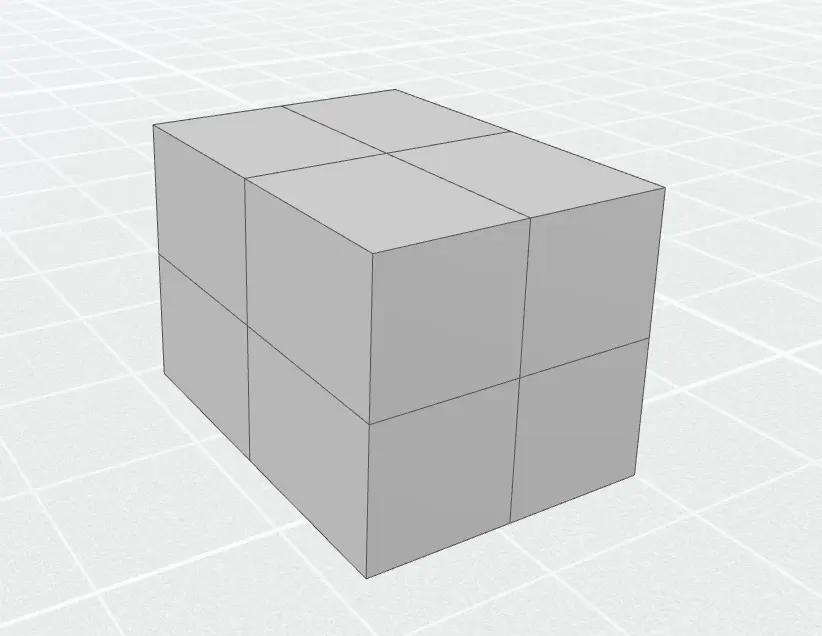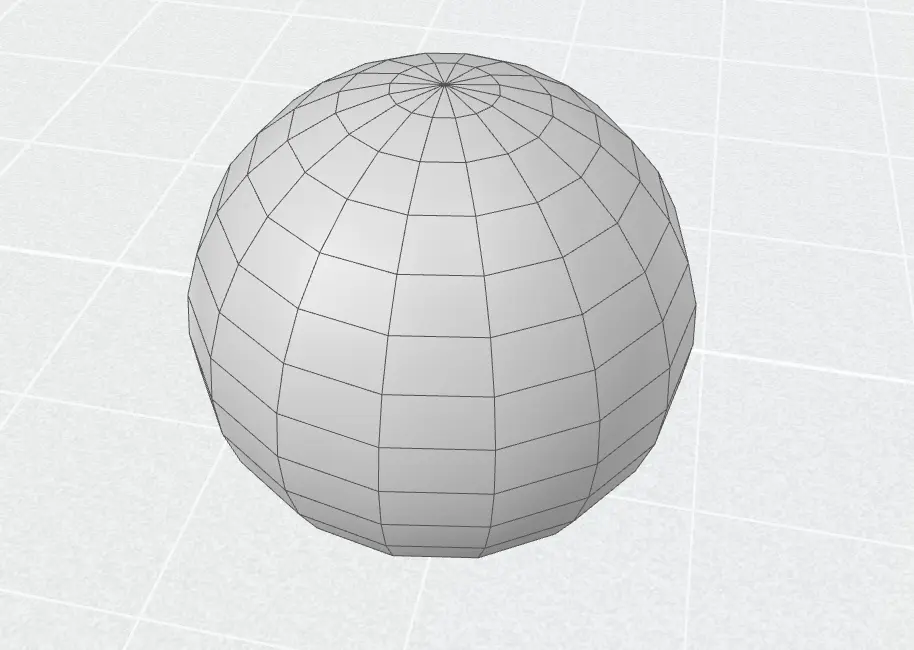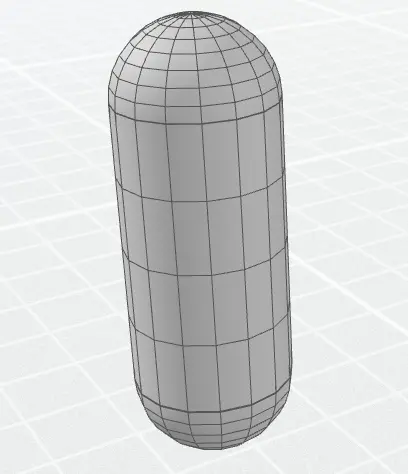Collider
Collider defines the actual physical characteristics of an object's response to collisions, which is typically invisible at the rendering layer. By setting the Collider component, the physical system can determine whether two objects intersect, resulting in a collision effect.
Overview of Collider Components
We have encapsulated the following common types of collider shapes for user convenience:
- Box Collider

import { ColliderComponent, BoxColliderShape } from '@orillusion/core'
// some codes here to create object...
let collider = object.addComponent(ColliderComponent);
collider.shape = new BoxColliderShape();
// set shape parameters...
collider.shape.size = new Vector3(2, 2, 2);| Parameter | Type | Description |
|---|---|---|
| size | Vector3 | The size of the box collider. By default, the center of the box is at the object's center, and the length of the box is specified by creating a new instance of Vector3 and setting the length along the x, y, and z axes respectively. |
- Sphere Collider

import { ColliderComponent, BoxColliderShape } from '@orillusion/core'
// some codes here to create object...
let collider = object.addComponent(ColliderComponent);
collider.shape = new SphereColliderShape();
// set shape parameters...
collider.radius = 5;| Parameter | Type | Description |
|---|---|---|
| radius | number | The radius of the sphere collider. By default, the center of the sphere is at the object's center. |
- Capsule Collider

import { ColliderComponent, BoxColliderShape } from '@orillusion/core'
// some codes here to create object...
let collider = object.addComponent(ColliderComponent);
collider.shape = new CapsuleColliderShape();
// set shape parameters...
collider.radius = 2.5;
collider.height = 10;| Parameter | Type | Description |
|---|---|---|
| radius | number | The radius of the upper or lower half-sphere of the capsule collider. |
| height | number | The height of the capsule collider. By default, the center of the capsule is at the object's center. |
Example of Applying Collider Components
After adding a Rigidbody component to an object, we can add a collider and specify the shape type of the collider to make the object respond to collisions:
import { Vector3D, Object3D, ColliderComponent, BoxColliderShape } from '@orillusion/core'
import { Rigidbody } from '@orillusion/physics'
let object = new Object3D();
object.addComponent(Rigidbody);
let collider = obj.addComponent(ColliderComponent);
collider.shape = new BoxColliderShape();
collider.shape.size = new Vector3(2, 2, 2);By using collider components, we can simulate realistic physical effects. The following example demonstrates a more complex scenario to further understand the effects that can be achieved through the physical system.
TIP
Starting from @orillusion/physics@0.3, we recommend using native Shape of Ammo to manage collision bodies,such as btStaticPlaneShape btBoxShape btSphereShape btCapsuleShape btCylinderShape, etc., which allow for more complex shape control
import { Engine3D, LitMaterial, MeshRenderer, BoxGeometry, Object3D, Scene3D, View3D, Object3DUtil, Vector3, AtmosphericComponent, DirectLight, SphereGeometry, CameraUtil, HoverCameraController, BitmapTexture2D, VertexAttributeName, Color, CylinderGeometry, TorusGeometry, ComponentBase } from "@orillusion/core";
import { TerrainGeometry } from "@orillusion/geometry";
import { Graphic3D } from "@orillusion/graphic";
import { Ammo, CollisionShapeUtil, Physics, Rigidbody } from "@orillusion/physics";
class Sample_MultipleShapes {
scene: Scene3D;
terrain: Object3D;
gui: dat.GUI;
async run() {
// init physics and engine
await Physics.init();
await Engine3D.init({
renderLoop: () => Physics.update()
});
// shadow settings
Engine3D.setting.shadow.shadowBias = 0.01;
Engine3D.setting.shadow.shadowSize = 1024 * 4;
Engine3D.setting.shadow.csmMargin = 0.1;
Engine3D.setting.shadow.csmScatteringExp = 0.8;
Engine3D.setting.shadow.csmAreaScale = 0.1;
Engine3D.setting.shadow.updateFrameRate = 1;
this.scene = new Scene3D();
// Setup camera
let camera = CameraUtil.createCamera3DObject(this.scene);
camera.perspective(60, Engine3D.aspect, 0.1, 800.0);
camera.enableCSM = true;
let hoverCtrl = camera.object3D.addComponent(HoverCameraController);
hoverCtrl.setCamera(0, -25, 100);
hoverCtrl.dragSmooth = 4;
// Create directional light
let lightObj3D = new Object3D();
lightObj3D.localRotation = new Vector3(-35, -143, 92);
let light = lightObj3D.addComponent(DirectLight);
light.lightColor = Color.COLOR_WHITE;
light.castShadow = true;
light.intensity = 2.2;
this.scene.addChild(light.object3D);
// init sky
let atmosphericSky = this.scene.addComponent(AtmosphericComponent);
atmosphericSky.sunY = 0.6;
// Setup view
let view = new View3D();
view.camera = camera;
view.scene = this.scene;
Engine3D.startRenderView(view);
// init terrain and create static planes
await this.initTerrain();
this.createStaticPlanes();
this.scene.addComponent(BoxGenerator);
}
async initTerrain() {
// Load textures
let bitmapTexture = await Engine3D.res.loadTexture('https://cdn.orillusion.com/terrain/test01/bitmap.png');
let heightTexture = await Engine3D.res.loadTexture('https://cdn.orillusion.com/terrain/test01/height.png');
const width = 100;
const height = 100;
const terrainMaxHeight = 60;
const segment = 60
// Create terrain geometry
let terrainGeometry = new TerrainGeometry(width, height, segment, segment);
terrainGeometry.setHeight(heightTexture as BitmapTexture2D, terrainMaxHeight);
let terrain = new Object3D();
let mr = terrain.addComponent(MeshRenderer);
mr.geometry = terrainGeometry;
let mat = new LitMaterial();
mat.baseMap = bitmapTexture;
mat.metallic = 0;
mat.roughness = 1.3;
mr.material = mat;
this.terrain = terrain;
this.scene.addChild(terrain);
// Add rigidbody to terrain
let terrainRb = terrain.addComponent(Rigidbody);
terrainRb.shape = Rigidbody.collisionShape.createHeightfieldTerrainShape(terrain);
terrainRb.mass = 0; // Static rigidbody
terrainRb.margin = 0.05;
terrainRb.isDisableDebugVisible = true;
terrainRb.friction = 1;
}
// Create static planes for boundaries
createStaticPlanes() {
// Create bottom static plane
let staticFloorBottom = Object3DUtil.GetPlane(Engine3D.res.whiteTexture);
staticFloorBottom.y = -500;
staticFloorBottom.transform.enable = false;
this.scene.addChild(staticFloorBottom);
let bottomRb = staticFloorBottom.addComponent(Rigidbody);
bottomRb.shape = CollisionShapeUtil.createStaticPlaneShape();
bottomRb.mass = 0;
// Create top static plane
let staticFloorTop = Object3DUtil.GetPlane(Engine3D.res.whiteTexture);
staticFloorTop.y = 100;
staticFloorTop.transform.enable = false;
this.scene.addChild(staticFloorTop);
let topRb = staticFloorTop.addComponent(Rigidbody);
topRb.shape = CollisionShapeUtil.createStaticPlaneShape(Vector3.DOWN);
topRb.mass = 0;
}
}
class BoxGenerator extends ComponentBase {
private lastTime: number = performance.now(); // Save last time
public container: Object3D;
public interval: number = 1000; // Interval for adding shapes
public totalShapes: number = 30; // Maximum number of shapes
async start() {
this.container = new Object3D();
this.object3D.addChild(this.container);
}
// Update loop
public onUpdate(): void {
let now: number = performance.now();
if (now - this.lastTime > this.interval) {
if (this.container.numChildren >= this.totalShapes) {
let index = Math.floor(now / this.interval) % this.totalShapes;
let shapeObject = this.container.getChildByIndex(index) as Object3D;
shapeObject.localPosition.set(Math.random() * 60 - 60 / 2, 40, Math.random() * 60 - 60 / 2);
shapeObject.getComponent(Rigidbody).updateTransform(shapeObject.localPosition, null, true);
} else {
this.addRandomShape();
}
this.lastTime = now; // Save current time
}
}
private addRandomShape(): void {
const shapeObject = new Object3D();
let mr = shapeObject.addComponent(MeshRenderer);
let mat = new LitMaterial();
mat.baseColor = Color.random();
let size = 1 + Math.random() / 2;
let height = 1 + Math.random() * (3 - 1);
let radius = 0.5 + Math.random() / 2;
const segments = 32;
let shape: Ammo.btCollisionShape;
let shapeType = Math.floor(Math.random() * 6); // Six basic shapes
switch (shapeType) {
case 0: // Box shape
mr.geometry = new BoxGeometry(size, size, size);
mr.material = mat;
shape = CollisionShapeUtil.createBoxShape(shapeObject);
break;
case 1: // Sphere shape
mr.geometry = new SphereGeometry(radius, segments, segments);
mr.material = mat;
shape = CollisionShapeUtil.createSphereShape(shapeObject);
break;
case 2: // Cylinder shape
mr.geometry = new CylinderGeometry(radius, radius, height, segments, segments);
mr.materials = [mat, mat, mat];
shape = CollisionShapeUtil.createCylinderShape(shapeObject);
break;
case 3: // Cone shape
mr.geometry = new CylinderGeometry(0.01, radius, height, segments, segments);
mr.materials = [mat, mat, mat];
shape = CollisionShapeUtil.createConeShape(shapeObject);
break;
case 4: // Capsule shape
mr.geometry = new CylinderGeometry(radius, radius, height, segments, segments);
mr.material = mat;
const { r, g, b } = mat.baseColor;
let topSphere = Object3DUtil.GetSingleSphere(radius, r, g, b);
topSphere.y = height / 2;
let bottomSphere = topSphere.clone();
bottomSphere.y = -height / 2;
shapeObject.addChild(topSphere);
shapeObject.addChild(bottomSphere);
shape = CollisionShapeUtil.createCapsuleShape(shapeObject);
break;
case 5: // Torus shape (convex hull shape)
mr.geometry = new TorusGeometry(radius, size / 5, segments / 2, segments / 2);
mr.material = mat;
shape = CollisionShapeUtil.createConvexHullShape(shapeObject);
break;
default:
break;
}
const posRange = 60;
shapeObject.x = Math.random() * posRange - posRange / 2;
shapeObject.y = 40;
shapeObject.z = Math.random() * posRange - posRange / 2;
shapeObject.localRotation = new Vector3(Math.random() * 360, Math.random() * 360, Math.random() * 360);
this.container.addChild(shapeObject);
// Add rigidbody to shape
let rigidbody = shapeObject.addComponent(Rigidbody);
rigidbody.shape = shape;
rigidbody.mass = Math.random() * 10 + 0.1;
rigidbody.rollingFriction = 0.5;
rigidbody.damping = [0.1, 0.1];
// Enable continuous collision detection (CCD)
const maxDimension = Math.max(size, height, radius);
const ccdMotionThreshold = maxDimension * 0.1; // Set motion threshold to 10% of max dimension
const ccdSweptSphereRadius = maxDimension * 0.05; // Set swept sphere radius to 5% of max dimension
rigidbody.ccdSettings = [ccdMotionThreshold, ccdSweptSphereRadius];
}
}
new Sample_MultipleShapes().run();
